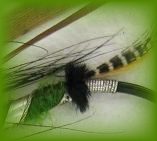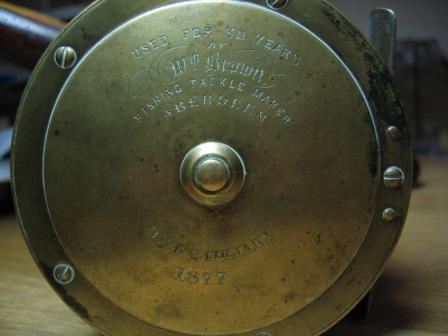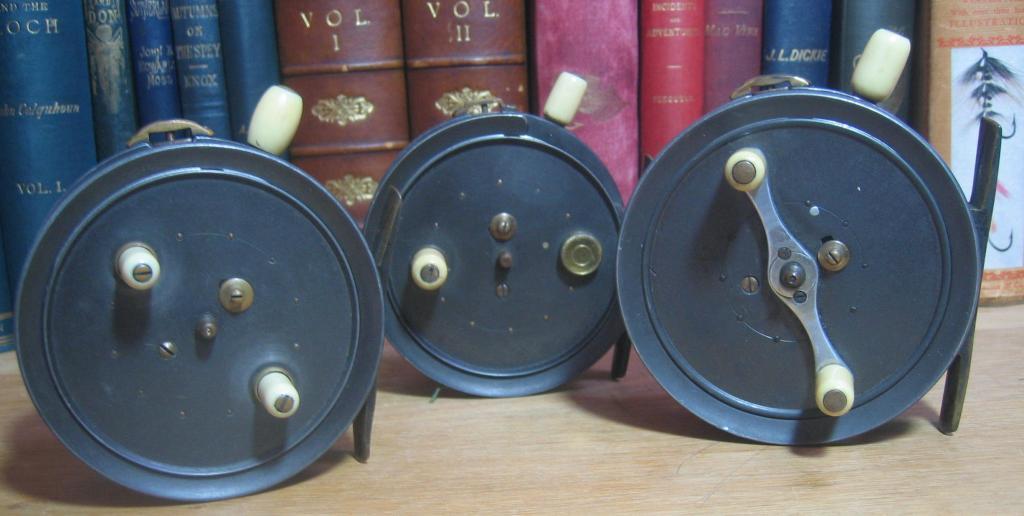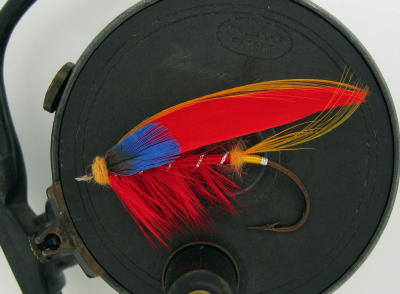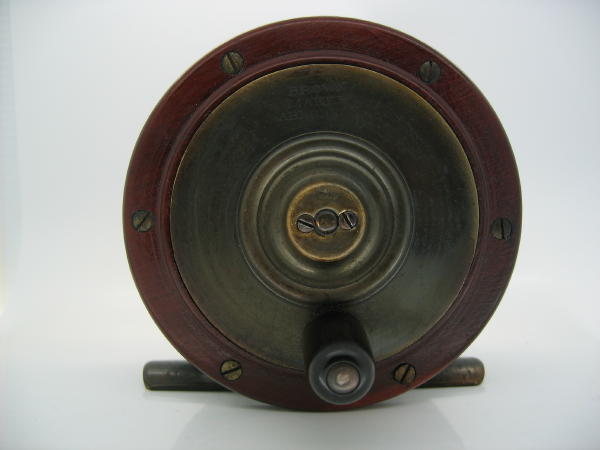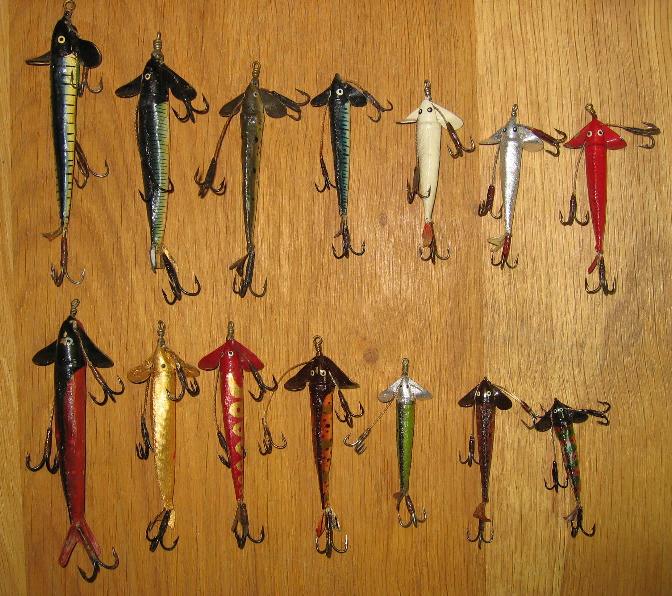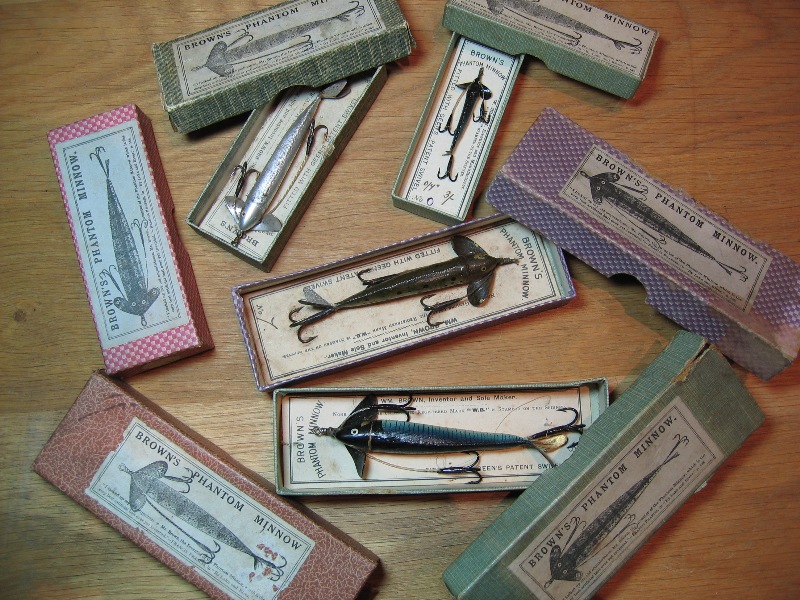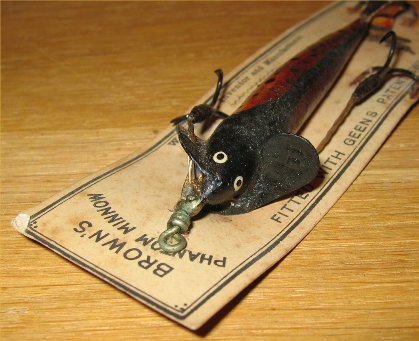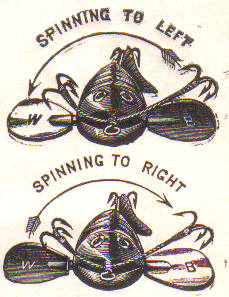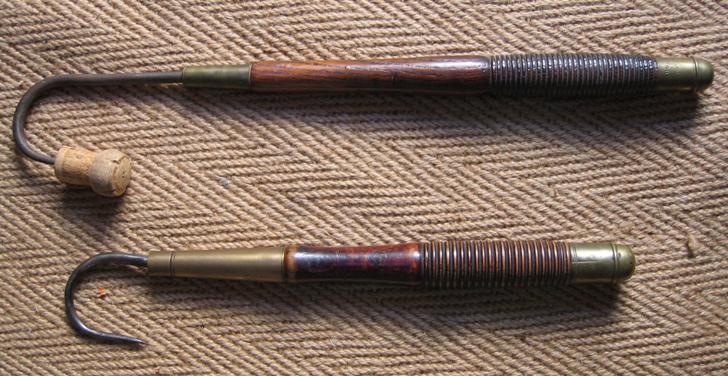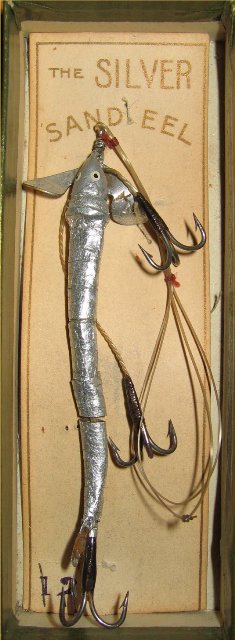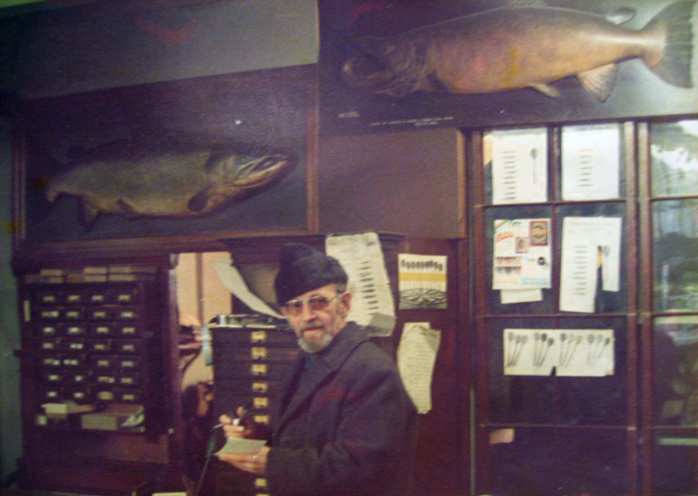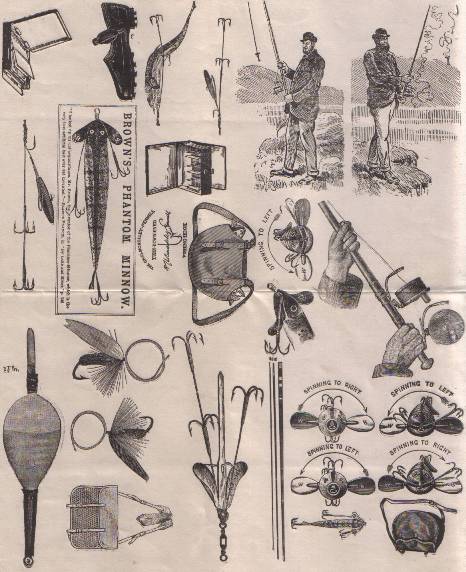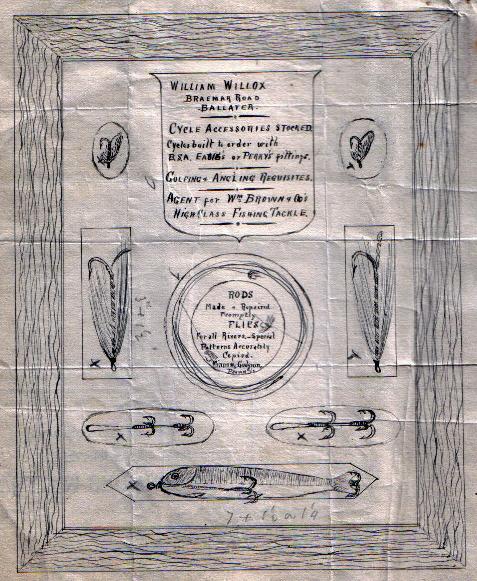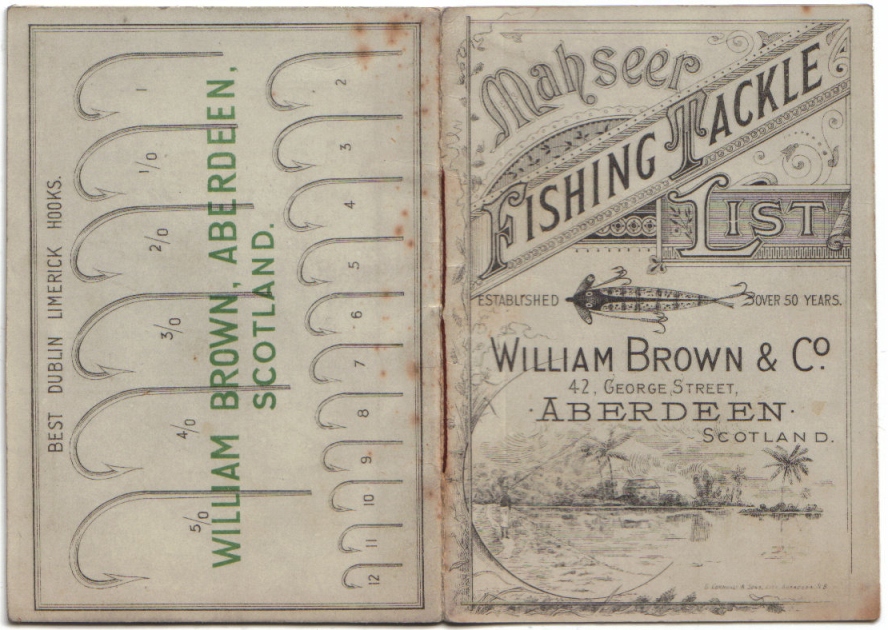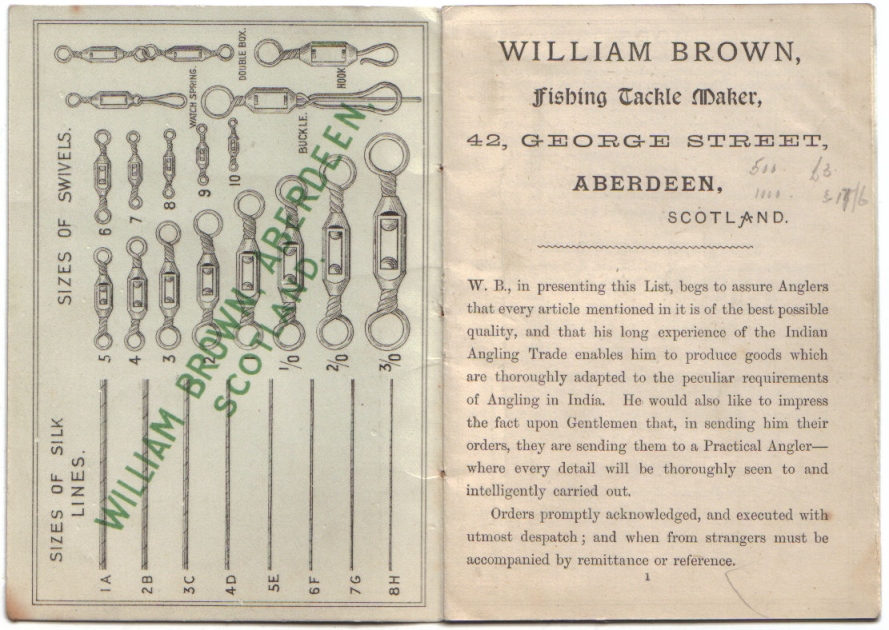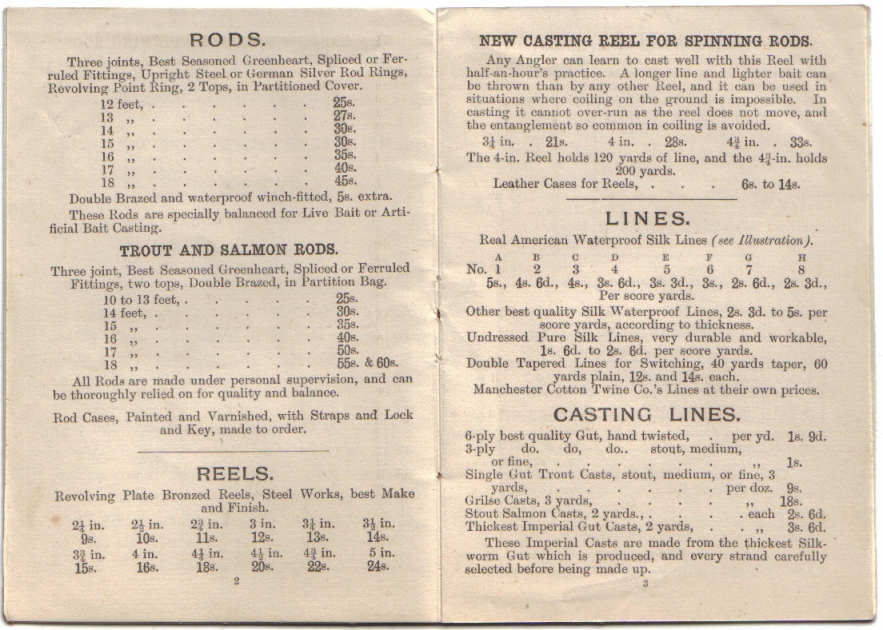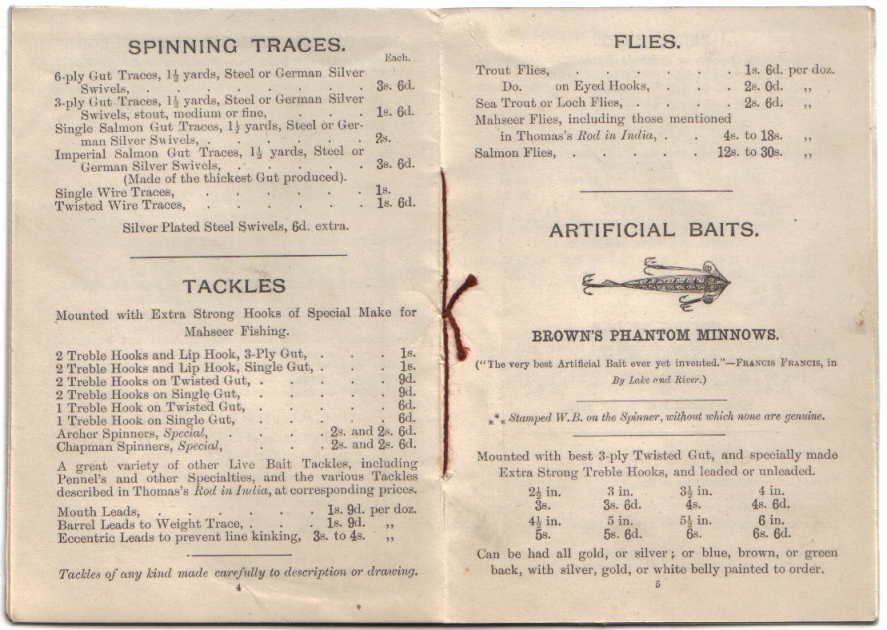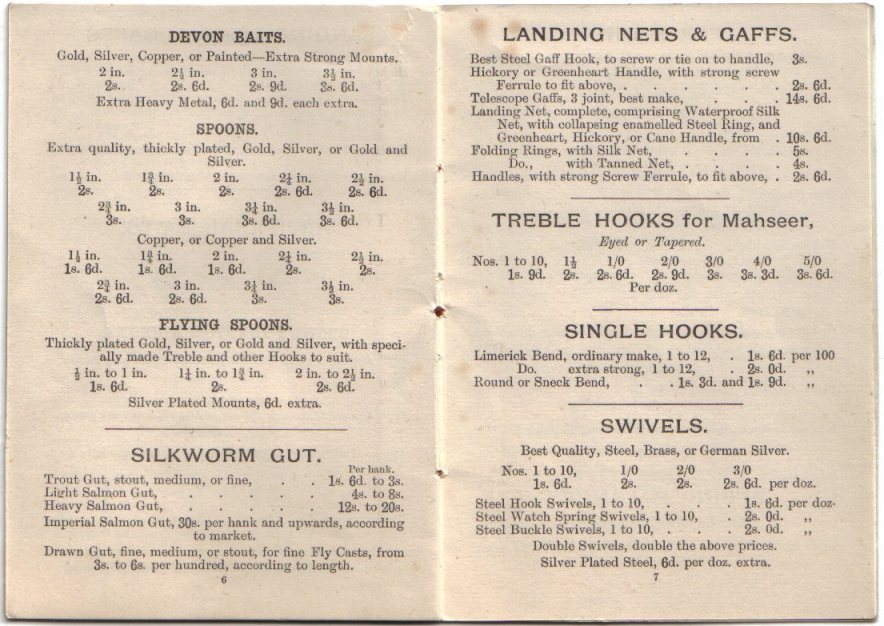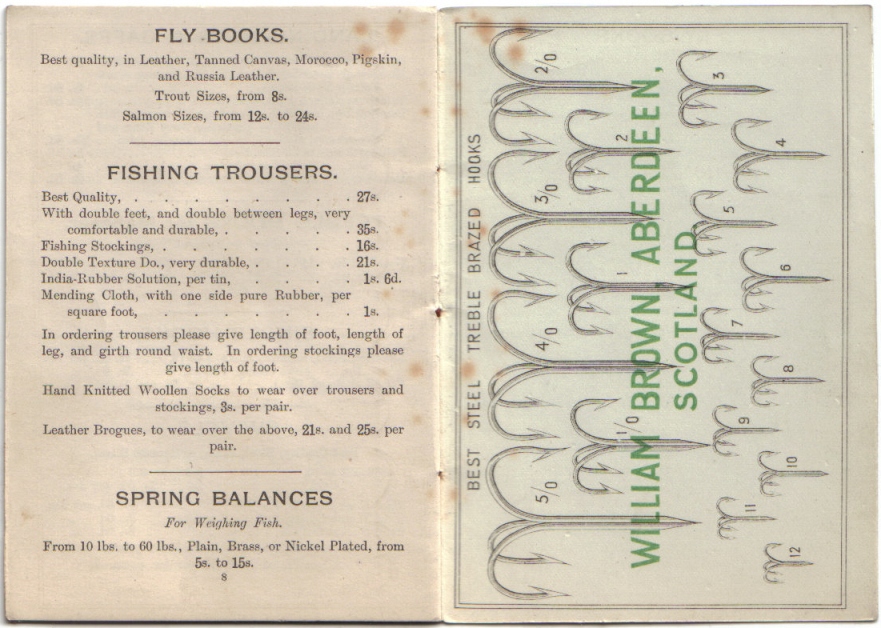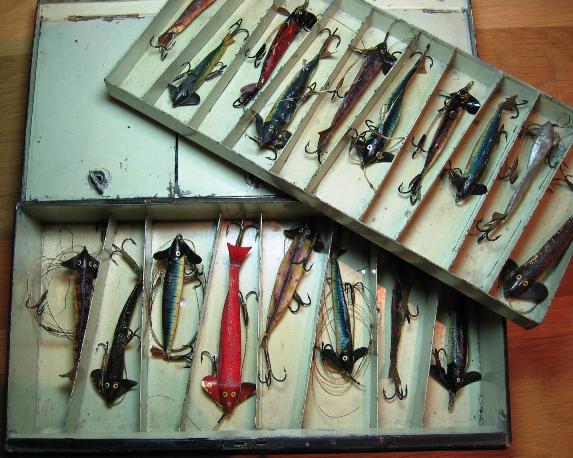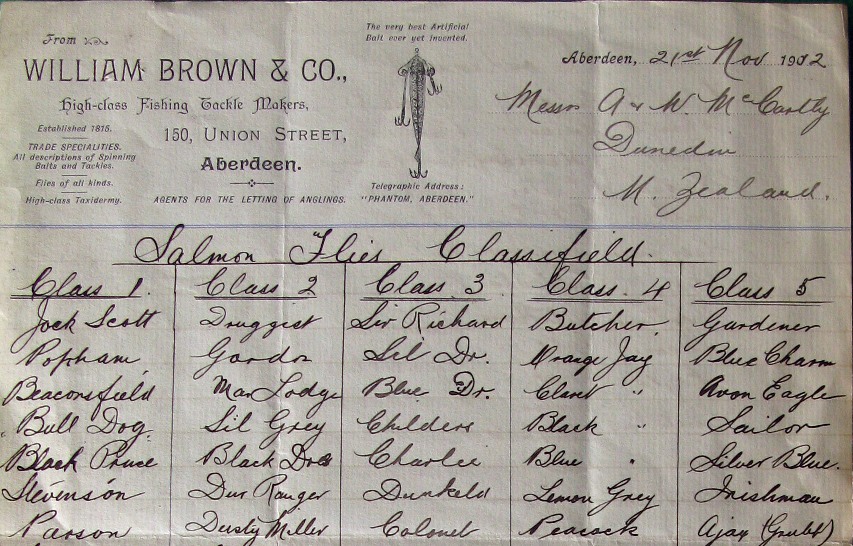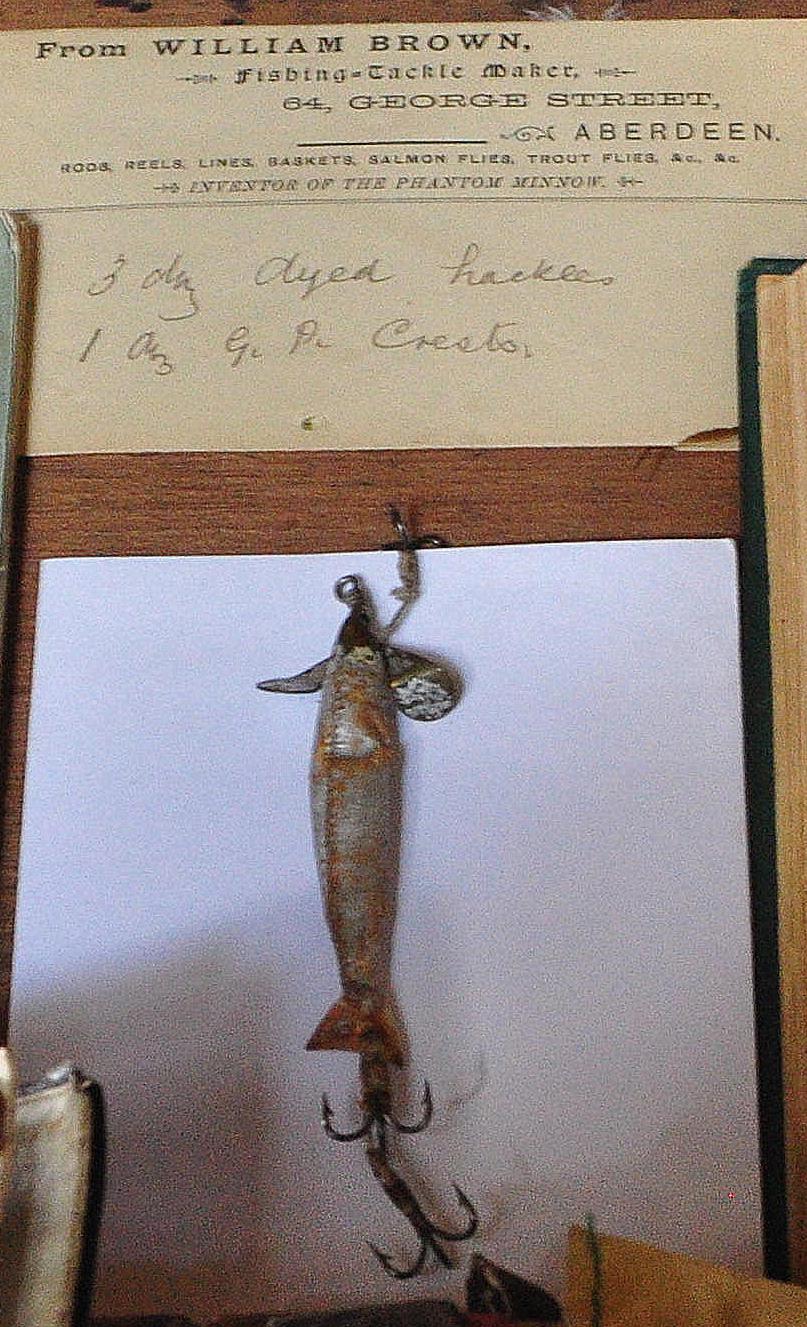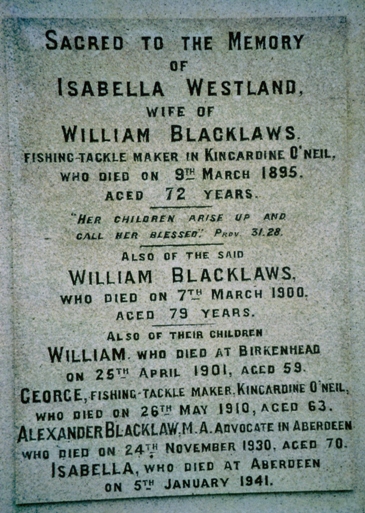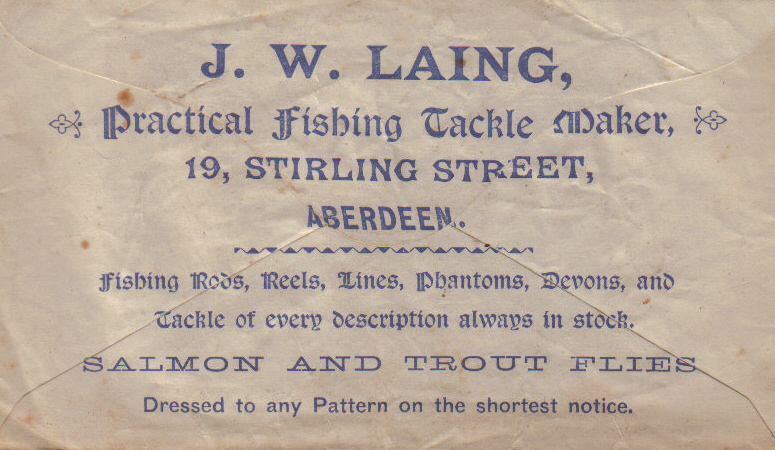 |
 |
|
On this Page William Brown, William Blacklaws and J.W Laing William Brown ‘Man, do ya think a fish wad be sic a fule as come to a man that hadna a flask in his pouch?'
1835 – 1836 – 1839 – 1840 – 1888 – 1891 – 1908 – 1913 –
William Browns own reel engraved on the back "Wm Brown, Fishing Tackle Maker, Aberdeen, Died 24th Jan 1877
3 different "Silex" type spinning reels, manufactured by Walter Dingley, sold Browns and engraved on the reverse "Wm Brown, Aberdeen" see below for the mechanisims Above William Brown two knobs on spool 4 inch diameter (the one on the left in the picture of all three) William Brown one knob on spool with counterbalance, rim cut (obviously factory modification) 4 inch diameter (The one in the middle of the picture of three) Above William Brown wider drum than the others with knobs on alloy cross bar 4 1/4 inch diameter (the one on the right in the picture of three)
An ebonite and brass "perth" style reel from Brown in exceptional condition
You might be wondering about this one in the William Brown Page? Well it's a fly called the Millais and was tied by Dave Carne, this fly was invented by the tackle maker PD Malloch for his friend the artist Millais, the reel the fly is sitting on is a Malloch side-caster, made by Malloch and sold by William Brown (as engraved on the winding plate of the reel). From the Fishing Gazette, The “Millais” Salmon Fly (Invented by Sir John Millias: described and made by Mr. P.D. Malloch, Tag: Silver Tinsel and yellow floss silk Tail: Golden pheasant crest, and a few fibres of yellow macaw Butt: Yellow wool Body: Two turns of scarlet floss silk, the rest scarlet pig’s wool; oval silver tinsel, scarlet hackle run down over body; the same at shoulder. Wings: Taken from the scarlet ibis wing, over a crest, blue macaw feather at each side Head: Yellow wool
This is a very rare William Brown "Perth" salmon reel made of wood and brass and is in almost unused condition The above is another very rare reel from William Brown, it has a rim control not unlike the Hardy Marquis (i.e. the winding plate lips over the side) - the other strange thing about this reel is the three part horn knob!
The largest and the smallest sizes of the ordinary William Brown Phantoms
A selection of differeny colour Brown's phantoms
A selection of boxed Brown's Phantoms
Brown's designed a Phantom for fishing still water, the extra big fins made it go extra quick
When they go fast you get a kinky line, so.... you needed to reverse the spin of the minnow
This was called the Inskip Patent.... When you caught the salmon you probably had one of these to land it with...
A pair of early gaffs by William Brown
A nice boxed William Brown Silver Sandeel - not that common!
A shot of the interior of Willliam Brown's shop - may bring back memories for some A selection of natural bait mounts by William Brown Came in silver too
The above is a "proof" page of illustrations for William Brown in 1890's
The above is a drawing of a proposed William Brown advertising board for William Willox of Ballater, I know nothing of William Willox, but I would love to find this frame! William Brown and the Indian connection
The above scans come from a very rare catalogue - which came from the Harper Family - it may be the only one, written on page 2 in pencill are the prics for producing the catalogue in editions of 500 and 1,000. What is clear though is that Brown's did supply a lot of tackle to India in the late 1800's early 1900's, the following is a little story of my own; About the year 1998 I was ‘phoned out of the blue by a tackle dealer from the sounth coast of England, he told me the tale of 3 William Brown “Mahseer phantoms”, I was intrigued and asked him how he know they were “Mahseer phantoms”, he explained that they were of a large size and were contained in a custom made tin box – they had been recovered from India, he also mentioned that the chap who had sold them to him also thought that some where he had a similar box with 6 phantoms, a large reel and the accompanying rod – although he could not locate them. I was interested enough to pay the rather large price for the rather large lures – I was not disappointed when I eventually got them in my sweaty hands! I concurred that they were “Mahseer phantoms” stamped with the W & B on the fins and that the design of the phantom tin is very similar to that of some in design drawings from the William Brown archives and one that I already had for more conventional size phantoms (ie the partitions are of tapered form, see below) and left it at that.
Drawing of WB Phantom Box and Photo of a WB box for standard sized phantoms Fast forward to 2005 I was looking at ebay and noticed a set of 6 Phantoms in similar if not identical tin case – the seller didn't mention the size of the minnows so they did not look anything out of the ordinary, I also noted the seller was also listing a rather large brass reel inscribed with “Roorkee Foundry*”. Anyway to cut a long story short I bought the phantoms (for a very reasonable price) and a fellow collector bought the reel (again at a reasonable price due to quality of photo and description on the listing). On receipt of the phantoms – which were exactly the same, right down to the paper linings in the tin trays, I contacted the seller – turns out he was the brother of the seller of the set of three phantoms, he did not have the rod. I visited the buyer of the reel and we put the lures and reels together (the reel is a giant 6 inch diameter and very wide drum, probably by a
Remember that reel is 6" in diameter ! *Roorkee Workshop & Foundry were originally established to cater in Ganga Canal Works in 1843, on a very modest scale, comprising merely a timber yard, a smithy and a carpenter's shop. In 1848, Lieutenant A. Allan was appointed to take charge of the establishment, who developed spacious buildings with lathe, model and engine-room accommodation, while in 1851, further large installation of machinery was made. In 1852, the connection between Workshop and the Canal was severed, and the workshop became an independent and self-supporting institution undertaking the supply of iron and wood for general purposes, manufacture & repair of mathematical instruments and iron foundry. By 1871, it afforded employment to 1,069 artisans and labourers, engaged in work of very wide range.
*Actual spelling used ** In both class 3 & 4 *** Could be Irishman’s Stockings ?
"Class 9: This class represents a few flies rather plainer in dressing than class 8. They are very often modifications of higher priced dressings NB: There are frequently two dressings (sometimes more) of one fly, varying more or less in value and effect. Our list represents in all cases the better known salmon fly dressings. The plainer dressings are omitted to avoid confusion"
I found the following letter sent to James Harper when he was proprietor of Brown's, we mostly think of Bouglé as the designer of a very desirable varient of the Hardy Perfect reel (and also the currently made version) but he was also a big shot in the world of spin casting.
157 Faubourg Saint-Honoré November 1st 1905 Dear Sirs, On my return after an absence of several weeks I find your favour of the 10th with sample of your fine undressed spinning line. My opinion is that for casting light weights from the reel either for light spinning or for tournament work this line ought to answer admirably. Some American anglers of my acquaintance and myself have been for some time past trying to get something of the kind. Quite recently the makers of the American “Kingfisher” lines have, at the request of my friend Mr C. G. Levison, issued new style of thin undressed line of which I received a 100 yards spool last September. It is the same firm who is making the No. 77 Kingfisher line of which I sent you a sample last year and which I have been using with great satisfaction for pike and salmon spinning for several years. I enclose sample of their new thin sort do you may compare it with yours. According to the label on the spool “This line will only stand a test of 4 or 5 pounds, it is intended for professional casting or small brook trout” Your line is slightly finer than the American ones and as regards strength it seems quite strong enough though I have not had time to find its breaking weight. I wish you to send me if possible 50 yards of this line of yours. I think you would do well to send a small cut of the same like that which you have sent me to my American friend Mr C. G. Levison of Mr Levison takes great interest in these matters and he has largely contributed to improve and refine the bait casting tackle used in the states. He is always on the committee of the Mr Levinson I might add has been using for many years with great success your phantom baits and it was he who advised me to adopt the “Inskip” style. The new Kingfisher line of which I enclose sample is much more expensive than yours ($1.50 per 100 yards) so that if in a practical trial yours answers well it is sure to be preferred by all of us. In your last letter you say, “We intend waterproofing it also”… This I do not very well understand unless you simply mean a coat of paraffin such as is often applied to these bait casting lines in It is only for casting “from the coil” that a dressed line (in the ordinary sense of the word) line is required and then it must be a thick line so the fingers of the operator may easily catch hold of it but them this is altogether another purpose. As above explained I consider nothing but a simple coat of paraffin is desirable for lines which are to used in casting from the reel. The No 77 American “Kingfisher” line of which I sent you a sample last year is said by the makers to be thus treated. Such dressing I have often applied myself to some of my bait casting lines and I intend to treat the thin new Kingfisher of which I enclose sample. This is how I do it: I simply melt some paraffin was in a tin can and when very hot I place the line in it. I leave it to soak about 15 minutes the paraffin being kept hot and then I lift the line out; I place it on an old newspaper until the paraffin has hardens and it may then be rubbed off the line with a piece of sort rag held by one’s fingers and the line pulled between folds in the rag. When first used after the paraffin is on it may not render from the reel as freely as necessary but it will run smoothly very soon and I believe this coat of paraffin must have a happy influence on the durability of the line. You may possibly find that this treatment may affect the appearance or shop finish of the line and not help to its sale. This may be so but anyhow I would advise you to on no account give it a linseed oil dressing. As you may not remember the No. 77 Kingfisher to which I make allusion in the present letter I enclose another sample of it. I also send you a sample of a very popular American flax line for salt-water fishing which may interest you to see. This line which is called the “Cuttyhunk” line and manufactured by J.S. Johnson & Co. is used in this size by American anglers for sea fish running up to 75 or 80 pounds such ad their striped bass. Is it not interesting to compare such line with the very coarse line used by British sea anglers especially considering that he latter have very seldom indeed to deal with fish of more than 20 pounds. All the rest of the equipment of American sea anglers is light and refined in the same proportion. Excuse this very long letter which may be of little interest to you and believe me dear sir, Yours truly L Bouglé
P.S. To sum up the matter the points which Mr. Levison and I require in a line for bait casting from the reel are: It should be as light and thin as possible for a given strength so as not to check the flight of the lure. It should be as tightly plaited and consequently stiff as possible so as to have little tendency to kink. It should on no account be made with a core because a line thus made picks up too much water and consequently swells with the result that it’s weight and size increase considerably after a few casts and also because a line with a core is bound to rot very soon.
With such tackle and one of your No. 4 Blue and Silver phantoms I killed last April a 21 pound fresh run salmon in the river Wye, in
The following letters were founc amongs some files of correspondance in the archive of "William Brown" material - makes interesting reading.
Camp, 15th September, 1893. Wm Brown Esq., I got your letter – No 547 – a few days ago. Everything came safely and the way in which you have filled my order leaves nothing to be desired. I regret to add that fishing is almost a blank. I leave my river today and move up into the mountains after the stags. The failure in the fishing is due to the Salmon. Trout is our game fish – trout in the river commonly 4lb – 6lb, in the lake 20lb – 30lb. Salmon don’t take the fly except on a few waters close to the sea, in spring, and even then the minnow is more in his line. But I am 300 miles up stream: by the time the salmon has forced his way thus far up the raring Fraser river he is a sorry looking object: still the big strong species (there are three species) is excellent eating. I have seen the great Fraser packed from bank to bank with a heavy squirming mass of fish and when Bridge River conflicts, such a jam that the weaker fish fall back by millions to die. So I can quite understand navigation (as you remark) being to some degree impeded, though I only tell you what I myself can vouch for. Thus the tributary streams are so disturbed by the salmon that the trout fishing is at a standstill, until - say - 1st October: by that time the salmon will have spawned and (for the most part) died: the trout will have had gorge on the spawn and will be eager for the fly and in the primest condition: I shall then return to this river. Also that most pig headed and ignorant of public departments – The Canada Fishery – has one cast iron law for the whole vast dominion: this stops trout fishing on the 15th of October: now as far as weather goes one could fish generally to the 1st of November very pleasantly: as to the trout he remains in prime order up to the 15th of April: then (in this river) he begins spawning and a paternal government has withdrawn protection as the season open on the 1st of February. Of course what is wanted is a system of local boards to regulate seasons in localities. I have thought that some account of these matters might interest you and some of your customers: you perceive, however, that my letter is slip slop – written in a spare half hour – I am shifting camp (as I say) today. Don’t let my name get into the papers please, by any mischance. I enclose $20 – but this is guesswork – I know it is somewhere about the mark. Faithfully yours, J Martley PS the trolling rod you sent is a very fine one indeed.
Camp, 7th September, 1896. Mr D. Bell (Wm Brown & Co.), My dear Sir, - Last week I had the very finest trout fishing which has been given me to enjoy in any part of the world. Working with both fly and minnow, comparison between the “Devon” and your “Phantom” was forced on me with the conclusion that your minnow is as sportingly – artistic lure – greatly preferable, yet when capture of the large fish is the object the “Devon” takes the cake: I lose many fish with your minnow – lose them, not by the inevitable chance of sport, but just by them “getting away”: after the rush is stopped and the fish turned and you say “bar accidents, I have him” your minnow comes back: not so with the devon it is less attractive than your minnow; less sportsman like; but far more deadly. Hence, I inquire with much diffidence “is the hook arrangement of your phantoms as perfect as it might be?” In seven out of ten the It may also be that the minnow of yours which I am using are too small for the 3lb to 10lb trout in rushing water, and that larger minnows and hooks would leave nothing to be desired. The Geen’s leads are simply perfect: a few lead worms (to slip one, or part of one, on) in addition to the Geens are often a convenience. Yours faithfully, J Martley P.S. No beastly salmon up this season – or not enough to affect the fishing. The following extract from the next letter was printed in the William Brown 1897 catalogue: “12th September, 1896. “Dear Sir, - I am much obliged for your letter – date I cannot quote; it is somewhere in my tent. Things get all over the place in camp. “Day before Yesterday, 8 A.M. to 9.30 P.M., spinning at the mouth of Portage Creek with the Phantom, grassed six and missed one. Best of the six, 3 lbs. “Afternoon, same day, head of Portage Creek, water swift and strong, rain. Killed half a dozen from 2 P.M. to 4 P.M. with a big brown fly of yours, gold ribbed, which my friend J.S.B. gave me. Canoe capsized; saved everything except my hat, and so back to camp. Bad rise, which was accounted for by thunderstorm at 6 P.M. “This season, though I have basketed many, my best has only scaled 6 lbs. (on a Brown Speckled Phantom). “The wear and tear on your fragile-looking Phantoms stand surprises me…-Yours faithfully, J. Martley, Captain.” The actual letter tells a slightly different story! Camp, 12th September, 1896. Mr D. Bell (Wm Brown & Co.), My dear Sir, - I am much obliged for your letter – date I cannot quote; it is somewhere in my tent. Things get all over the place in camp. Day before Yesterday, 8 A.M. to 9.30 P.M., spinning at the mouth of Portage Creek: grassed 3 with the devon; and missed 3: put up one of your phantoms (silver) on which I had clumsily fitted an extension triplet (see my last letter on the point): killed 3: missed 1, best of the six 3lb (phantom), least of the six 1½lb. I found the addition to your minnow - makes it in my opinion – perfect: shall you object to fit my minnows with it in the future? Afternoon, same day, head of Portage Creek, water swift and strong, rain. Killed half a dozen from 2 P.M. to 4 P.M. with a big brown fly of yours, gold ribbed, which my friend J.S. Bell gave me: Canoe capsized; saved everything except my hat, and so back to camp. Bad rise, which was accounted for by thunderstorm at 6 P.M. This season, though I have basketed many, my best has only scaled 6 lbs. (on a Brown Speckled Phantom). The wear and tear on your fragile-looking Phantoms stand surprises me. Thanks for the suggestion re “Fishing Gazette”. If you will kindly pass on my address I may try him with a paper later on - Faithfully yours, J. Martley. P.S. If my letters can be useful in anyway, make use of them – careful use – not necessarily all extracts.” So it would seem that, as now, accuracy or completeness is sometimes lost in the attempt to market a product. It would also appear that Captain Martley, had lost some of his publicity shyness between 1893 and 1896. Greetings from British Columbia...
Michael Kennedy
Hello Colin,
Born 1831 to an Anglo-Irish military family; Cork(?) Ireland.
Enrolled Sandhurst 1845 (age 14 yrs 9mos.)
Graduated Sandhurst 1849.
Commissioned into the 56 Regiment 6 July 1849. (West Essex Regiment of Foot) and ultimately Captain 9th Regiment of Foot.
Veteran Crimean War.
Married Maria Josephine (Ballingall) Eyre; widow/ five children, Bermuda, sometime after 1853
Sold commission 1861.
Sailed in 1861 for the new colony of British Columbia with their very young children(two) and the two daughters from Mrs. Martley’s first marriage.
1861-62 spent travelling over much of the southern interior of the colony examining potential farm land, finally settling on a substantial acreage north of the gold-rush centre of Lillooet near the hamlet of Pavillion. They were to reside there for nearly forty years creating the ‘show’ farm and stock ranch they named ‘The Grange’. From the earliest times, like many of the settlers in Cariboo, the Martley’s also operated a stopping place for travellers.
John Martley was one of three army officers who, under an 1861 proclamation, he qualified for a military grant of land in the new colony and which, though the process dragged on interminably, certainly may have influenced his decision to relocate.
1862- 96 led a very active life managing the Grange and whenever he could escape these responsibities went afield in pursuit of trout, upland gamebirds, and big game with which the colony (and then province) abounded. In this he often shared the good company of the numerous young Anglo-Irishmen and others who had taken up the challenge and sailed to the new colony and new opportunities; many of whom had been personally encouraged by the Colonial Office to apply for appointments there in the administration.
Social activity in the interior of the colony certainly lacked the opportunities that were provided by the early developing towns on the coast but with the early construction of roads and exploitation of waterways leading to the goldfields the easing of travel led to a regular flow of travellers and among them frequent visitors. The Martleys were active members of the core British settler population of the colony that was intent on maintaining its social practices and position.
1882 reinstated, assigned to Horse Guards and attached as A.D.C. to the Marquis of Lorne, Governor General of Canada, for the duration of the British Columbia Vice-regal tour. This was his most cherished honour; recognition for his decades of devotion to his chosen new homeland.
1878 appointed Justice of the Peace for Lillooet area.
1894 Published a volume of verse ‘Songs of the Cascades’; a tribute to his home region and a political commentary.
1893 Initiated a correspondence and began purchasing fishing tackle from Brown’s of Aberdeen.
1896 died 27th of October at home on The Grange. Both of the Martley’s are buried on The Grange in an enclosure with a rose bush on a high sloping pasture with a view to the south of the snow-capped Mt. Mclean. OK so William Blacklaws is not one of the Aberdeen makers, he was based in Kincardine O Neil a village (the oldest village) on Deeside, he is very important to the history of the area as a rod maker, fly maker and friend of William Brown.
The Blacklaws headstone at Kincardine O Neil The only example I have found of a reel with Blacklaws name - it's salmon sized
The Story of William Blacklaws Famous Fishermen – William Blacklaws, Fishing Gazette, 10th August 1889
It is now nearly three score years and ten since William Blacklaws, one of the best and best known fishermen in the Aberdeenshire Dee, and one of the most famous rod makers, in the world, first saw light near the banks of his favourite river- one of the finest salmon streams in the kingdom. He was born in 1820, in the parish of Banchory, about eighteen miles from the mouth of the Dee. Here the crystal stream sweeps rapidly over its pebbly bed. Its gently-sloping banks are richly clad with verdant fir, larch or pines, and here and there cultivated haughs break the line of wood and afford a pleasing variety grateful to the eye of the of the angling tourist, who finds at every turn exquisite bits of scenery which have given the valley of the Dee a world-wide celebrity as one of Scotland’s most beautiful spots. Here William Blacklaws passed his boyhood. He attended the parish school, but he spent all his holidays, and most of his play-hours, at the side of the Dee, and its neighbouring tributaries – especially the Feugh – catching trout with tackle of his own making and flies of his own dressing.
William’s father held the comfortable position of grieve or overseer at Banchory lodge, and was himself one of the most noted sportsmen on Deeside. He had been much about Blackhall castle, in the wild old days when Fitzzean, Lord Kennedy, Barclay of Urie, and kindred spirits indulged in their madcap escapades, and the old man was in the habit of relating with the greatest gusto the part he had played in the hare-brained “ploys” of these enthusiastic and ofttimes eccentric sportsmen. “Young William” was a true chip off the old block. He took a keen pleasure in all out-door sports, and was always ready for mischievous pranks. When quite a boy he killed his first salmon, and though he has since landed many scores of the royal silvery denizens, he still recounts his first conquest “with all a sportsman’s ecstasy.”
When his school days were over William was apprenticed as a gardener at Banchory Lodge, and a trick which he and his cousin, Jock Adam – still remembered on Deeside as they famous Feughside blacksmith and salmon slayer – played on his father shows what manner of a boy he was. The elder Blacklaws was, it must be explained, a great tier of flies, and, if anything, conceited as to the particular size of the irons. One day, early in spring, he was observed by the two lads to be “tearing up and down,” as they phrased it, in a great rage at the carrier because the three-inch irons which he had bought from Aberdeen were too small. The youths resolved to satisfy the “Old Boy,” and Jock, who was already a proficient in smith work, forged an iron three feet long, barbed, and all complete, and William dressed the hook with peacock and turkey-cock feathers after the orthodox pattern. It was neatly made up into a parcel, and duly delivered on the opening days. In a note which accompanied it the hope was expressed that Mr. Blacklaws would find it large enough, at any rate. The old man was furious; but his tormentors enjoyed the joke immensely.
When “Young William” had completed his apprenticeship he was retained as a gardener at Banchory Lodge, and by-and-by he began to think that it was not good for a man to be alone. We do not propose telling the story of his courting days, but there is one exciting episode which must not be passed over. His sweetheart was in the service of an old lady who lived on the banks of the Feugh, and one night about dusk, as is still the custom of the country, “Young William” set out for the domicile of his beloved. Reaching the back window he, as is usual on such occasions, tapped lightly on one of the panes. As bad luck would have it the whole household had been thrown into confusion by the sudden arrival of the old lady’s son from abroad, and he was moving about near the back window when the amorous signals were given. He immediately opened the door, and the expectant lover clasped, not the fair form of his darling, but the muscular frame of the six-foot son of her mistress. Both men were equally taken aback for a second, but the young master immediately returned the hug of the gardener, and both being powerful men, a desperate tussle ensued. Over and over they rolled, the one on top of the other, and down the embankment into the bed of the Feugh. The gardener landed uppermost, and the other combatant, who was stunned by the fall, relaxed his hold. William now saw his opportunity, and lost no time in showing a clean pair of heals.
Next day the “Battle of the Feugh” was the great sensation in Banchory. The police were searching everywhere, and a reward of five pounds was offered for the apprehension of the delinquent. “Old William” now delights to tell the story, and at this point he generally remarks – “It was twenty lang years and mair before I breathed a syllable to onybody that I kent onything aboot it. Luckily there was no real harm done. The young man had sair banes for a day or twa, but so had I, and what was waur, durstna sat a word aboot it.”
Shortly afterwards the young gardener married the heroine of the startling escapade, and his nocturnal visitations came to an end. He was happy in his choice, and his good wife still shares in all the joys and sorrows of his busy life. She has in no small measure, by her industry, thrift, and excellent management, contributed to the happiness and comfort which has all along attended their family circle, and support in times of difficulty and trial.
At Banchory Lodge at the onset of his career, “Young William” was happy in all his relations. His position was rightly considered a very comfortable one for his experience and station in life. In all probability he would have been content to remain there, and the world might have lost one of its finest rod-makers, had it not been for a disagreeable incident. He quarrelled with the coach-man, and after that the place was not large enough for them both. In justice to the subject of our sketch, matters must be explained. The coach-man kept a number of pigs, and in foraging for them he wrought sad havoc in the garden without asking leave or licence. This was more than any gardener with a just pride in his work could stand. It is, therefore, not at all surprising that “Young William” gave the coach-man a sound thrashing, when one morning, he found him ruthlessly despoiling the sacred cabbage beds. This incident, as Blacklaws recently remarked, led to “court martial.” The coach-man had grown old in service at Banchory Lodge, and was a great favourite, so matters at first looked very black for the young gardener; but when everything was known he was acquitted of all blame. What followed may be best explained in the words of Mr. Blacklaws himself. “I felt,” he says, “that the situation could not be comfortable or conducive to my piece of mind so long as the coach-man and I remained in the same employment, and, being the younger of the two, I felt it was my duty to give in my warning, and sorely against my mistress’s will I left Banchory Lodge a month afterwards.
Immediately after this Blacklaws took service with Mr. Harvey, of Cairnoustie, on Deveron side. Here he was gardener, keeper, and fisherman by turns, and he felt equally at home in all these diverse roles. He did not, however, remain long there, but, after a short interval, returned to his well-beloved Deeside. For three years after he was Mr. Winslow, tenant of Blackhall Castle; and on the famous Blackhall water he had every facility for increasing his proficiency as a fisherman. Here for the first time he saw what is commonly known as artificial minnow angling. “Mr. Winslow,” remarked Blacklaws, the other day, “had every engine then known for the killing of salmon. If a fish were seen to rise and refuse the fly and other lures, Mr. Winslow put over him his ‘minnow,’ which consists of a small, dry, salted garvie – white and silvery, that he kept in a small barrel – and I never saw it fail. It was the most deadly bait I ever knew. No matter how bright the day or how small and clear the water may have been, salmo took the garvie when he fought shy of everything else.
Blacklaws thought it was a lazy life in the winter time at Blackhall, as he had nothing to do but tie flies, make casts, and prepare tackle for the coming season. The monotony was, however, often relieved by a day on the hills among the roe deer, and whoever returned empty handed, the subject of our sketch was seldom of the number. He was a crack shot in his day, and even yet, although his sight is failing, he yields the palm to very few at any of the local hunts.
After leaving Blackhall he served some time at Borrowstone house, Kincardine O’Neil, where he laid out the present garden. Here he had the run of the fine pools belonging to the Borrwostone fishings, and he whipped many a silvery beauty from the Gannets, the Greenbanks, and the Bridge pools.
From Borrowstone house he passed into the service of Captain Farquar, Carlogie, now Admiral Sir Aurthur Farquar, K.C.B., Drumnagesk, Aboyne. Then began, in earnest, the work which has earned him his world-wide reputation. His duties at Carlogie were nominally those of a gardener, but he was so much sought after for the river and for the hill, that he was practically more of a keeper than anything else, and ultimately the garden was merely superintended by him in the seed and fruit seasons. He had for years been in the habit of repairing rods for gentlemen, and he did it so deftly that no one who could secure his services ever thought of sending a “break” to Aberdeen. He had, however never tried to make a rod, and it was apparently in the most casual way that he was first induced to make the experiment. When he came to Carlogie the gentleman who had rented the shootings and fishings had not arrived. Here was a fine water in which a salmon might at any time be killed; but there was no rod. Blacklaws, who by this time had a serviceable collection of tools, set to work, and in two days produced his first complete fishing rod – a spliced rod, with butt and middle joint of ash, and a lancewood top. His first attempt was a decided success. As soon as Mr. Natkins, the gentleman who had taken a sub-let of Carlogie, saw it, he was stuck with its fine balance, and having tried it, he ordered a similar one for himself. After this every sporting gentleman that came that way felt he was not fully equipped till he got Blacklaws to make him a rod, and for the next eleven years every moment of William’s spare time was devoted to the manufacture of those “favours” that were inevitably booked long in advance. He was now in possession of a good turning lathe and better tools, and the excellence of his workmanship kept pace with the gradual improvement of his apparatus. Admiral Farquar was often home on leave, or resting in the intervals of his appointments, and at such time he had always more or less company at Carlogie. New rods were more in demand than ever, and the fame of the rod maker was being carried further a field with every newcomer.
After eleven years’ service at Carlogie, and while considering the suggestion that had been made to him times without number by his patrons that he should start business on his own account as a professional rod-maker, Blacklaws accepted the offer of a lucrative engagement with Mr. Nicol Fleming, who then leased Kilkerran, in Ayrshire, the seat of Sir James Fergusson. Here the subject of our sketch remained three years, earning the good will of all he came in contact; and on leaving he carried with him several tangible tokens of the respect in which he was held, as well as a valuable presentation from Mr. Fleming himself “on account of the inestimable services he had rendered during his engagement.”
He now started business for himself in the village of Kincardine O’Neil as rod and tackle maker; and a short time after settling there he was joined by his son George, who is peerless as a tier of salmon flies, and is one of the best practical sportsman in Deeside. Blacklaws has been remarkably successful as a rod-maker, which must be regarded as the proper business of his life. He has supplied rods to most of the sporting nobility and gentry visiting the North of Scotland. He has a large and extensive connection with British Columbia, and he has many important commissions from Norway, Canada, and other distant countries where the gentle art is practiced. Among his patrons may be mentioned the Duke of Sutherland, the Duke of Marlbrough, the Duke of Rutland, the Marqius of Huntly, Viscount Arbuthnott, Viscount Summerton, Lord Randolph Churchill, Sir William C. Brooks. Bart., M.P., Admiral Sir Arthur Farquar, K.C.B., Admiral Dowell. C.B., Sir George Abercrombie, Sir William Cheter, Dr. Farquarson, M.P., Sir Reginald Cathcart, Dr Profeit, Her Majesty’s Commissioner, General D. Macintyre, V.C., etc.
“Old William” has in his day furnished rods of all the ordinary materials – ash, hickory, lancewood, washiba, and so on; but his favourite wood is greenheart. After prolonged experience he has ultimately preferred that wood to all others, and now he seldom makes a salmon or trout rod of anything else unless he is specially ordered to do so. He is extremely careful in the selection of his material, and when a new consignment comes to hand he has an anxious day of two until every inch of it has been carefully examined and assorted. It very often happens that during this process one-half of the consignment is discarded.
Blacklaws is a splendid fisher, and he still dearly loves a day at the water. Moreover he is often eminently successful when others fail. He has a rare knowledge of the habits of the fish and of the varying influences of climatic conditions. He can cast thirty or forty yards of line as straight as an arrow to the very stop he wishes to cover; but he never uses a foot more than he thinks necessary. This enables him to keep his line well in hand. He does not waste any power nor lose much time in killing his fish, yet he rarely loses one. It is also worth of being specially noted that he positively prefers to gaff his own fish, except when in company with an expert fisherman, and he performs this operation with wonderful dexterity. He prefers the fly to all lures, though he sometimes induced to spin with the Phantom. Like most famous fishermen he believes in a small selection of flies, and perhaps his most special favourites are the Eagle, the Gordon, the Grey Heron, and the Yellow Gaudie of his own tying. His angling experiences have been entirely confined to the Dee, except the short time he was on the Deveron and the three years he was in Ayrshire; but he has at various times fished the Dee all up and down from Ballater to the reaches below Park. At times “Old William” has landed as many as seventeen salmon in a day; but on such occasions very few of the fish were in a seasonable condition. He has, however, taken as many as eight clean salmon from the Bridge Pool at Potarch, on the Borrowstone water, in the course of a single day. He has twice landed autumn fish turning the scale at 38lb. He tells a very good story of a fish of that weight which he caught in the Quethal pool, on the Carlogie water. He had run the fish till it was ready for the gaff, and a gentleman who happened to be on the bank kindly volunteered to do the needful. He quickly waded to the place where the fish was rolling over and over in the shallows, and struck at it but missed. On making a second plunge the fish shot through his legs, and Blacklaws declares that he had to bring both man and fish to bank, the former on the latter’s back. On day at Banchory Lodge he landed twelve grilse and a salmon – a beauty of 13lbs. This was a grand days sport, but “there’s many a slip ‘twixt the cup and the lip.” William had no gaff with him, and after landing the salmon gave it to a lad to carry up the steep bank. Salmo, it appears, did not appreciate the joke, and giving a vigorous wriggle, sent the youth staggering back. He, to save himself, dropped the fish into the water, and it thus regained his liberty. The angler’s feelings can be better imagined than described, but it is greatly to his credit that he was not surprised out of his usual decorous mode of expression; but there is a general and probably well founded opinion that “an aith” might have relieved him.
It may be mentioned that when the late Mr. Brown of Aberdeen, was in the throes of the invention of his Phantom minnow, he had many consultations with his life long friend, Mr. Blacklaws, and when the invention was completed “Old William” was the first to use it on the Dee, casting it in the way he would a large salmon fly – a method that he still employs in preference to the spinning rod. An old angler was with him the first time he put on the phantom in a heavy autumn water. When he saw him land his third fish running he could stand it no longer, and, declaring that the very devil himself was in the thing, made off down the waterside in great wrath.
“Old William” is pre-eminently a salmon angler, but he is passionately fond of a days trouting, and at a fishing expedition to the hills he is seen at his best. He is as sprightly as the youngest of the company, and his society at all times, but especially on these fishing excursions, is a rare treat. Only those that have had the good fortune to have been in his company can have any idea of the fund of fishing lore, incidents of fishing and hunting parties, &c., at his command. When once on the water no time is wasted, and at the end of the day, however hard the toil, old Blacklaws is usually the freshest of the company, and as a general rule has the best filled basket.
JW Laing 1895 – John William Laing Died
|
